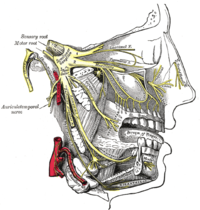
Photo from wikipedia
Trigeminal Neuralgia (TGN) is a horrific facial pain disorder that is paroxysmal, stabbing, shooting pain that affects the face due to compression of the trigeminal nerve. Literature has suggested that… Click to show full abstract
Trigeminal Neuralgia (TGN) is a horrific facial pain disorder that is paroxysmal, stabbing, shooting pain that affects the face due to compression of the trigeminal nerve. Literature has suggested that the use of an endoscope for microvascular decompression (eMVD), as opposed to a microscope alone, is more likely to identify the source of neurovascular compression and ensure that the nerve is adequately decompressed. MVD for TGN is successful in many patients however, this procedure still occasionally results in hearing loss, cerebellar injury, double vision, infection, dysesthesias, unresolved TGN facial pain, and cerebrospinal fluid leakage. Many of these adverse outcomes are a result of inadvertent damage to surrounding tissue from the surgical tools. Because eMVD requires less retraction, offers better visualization, and is less invasive it seems to be a promising technique in the surgical management of TGN. This retrospective chart review aims to explore the efficacy of eMVD for TGN by studying rates of adverse events and comparing them to the literature using descriptive statistics. This is the largest study to date evaluating complications associated with eMVD for TGN. In this cohort, adverse events include facial numbness (4.3%), dizziness (0.4%), ataxia (0.4%), diplopia (1.9%), infection (0.8%), spinal fluid leak (0.4%), stroke (0.4%), and chronic headaches (0.8%). There were no cases of facial paralysis, hearing loss, or dysphagia. Despite 2D visualization with the endoscope, neurologic injury does not appear to be any higher than with traditional 3D MVD and is safe in this patient population. The endoscope seems to be a very efficacious tool for TGN. In the literature for traditional MVD rates of adverse events are not consistent. In this cohort of patients, the rates of adverse events seem to be lower or similar to MVD. Regardless of technique, this surgery has low rates of complications so researchers should continue to monitor adverse outcomes to explore significant trends.
Journal Title: Neurosurgery
Year Published: 2019
Link to full text (if available)
Share on Social Media: Sign Up to like & get
recommendations!